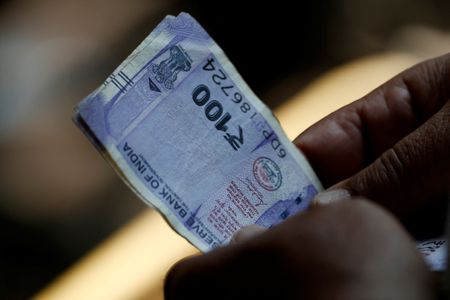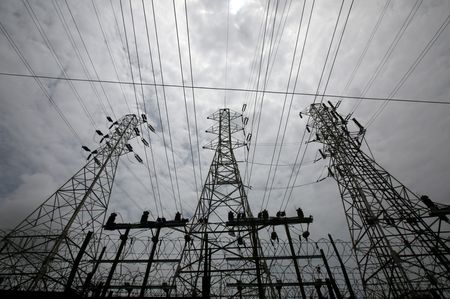By Vivek Mishra
BENGALURU (Reuters) -The Indian rupee will erase nearly all of the gains it has made against the U.S. dollar in the last two months and tumble back toward an historic low over the next 12 months, according to a Reuters poll of 36 foreign exchange analysts.
The partially-convertible rupee has gained around 3% over the past two months, ending a five-month losing streak and marking its largest monthly gain since November 2018, supported by a weaker dollar and renewed foreign capital inflows into equities.
However, most analysts in a latest Reuters poll expect the rupee’s recovery against the dollar to be short-lived based on slowing economic growth and expectations the dollar will not weaken much further in the coming months. [EUR/POLL]
The analysts also said expectations for the shortest easing cycle on record, with the Reserve Bank of India cutting interest rates by a total of 75 basis points, are likely to exert further mild downward pressure on the rupee.
The rupee was forecast to drop 1.9% to 87.18 per dollar in three months, then trade at 87.50 in six months and decline 2.6% to 87.80 by the end of March 2026, the poll found.
“The rupee has appreciated due to an unexpected slide in the broad dollar index and year-end inflows. The fundamental view is still of weakness, especially on account of potentially higher U.S. tariffs that can hurt exports and warrant a weaker currency,” wrote Dhiraj Nim, FX strategist at ANZ.
“Beyond the tariff-related adjustment, the path for the USD/INR could gradually trend higher. There is no merit in letting the currency appreciate meaningfully, especially given the need to recoup lost foreign exchange reserves,” he added.
Analysts in the poll said the rupee’s near-term outlook depends on U.S. President Donald Trump’s expected reciprocal tariff on major trading partners, set for April 2 and their impact on India’s exports and economic growth, which is already slowing.
Trump has singled out India as the country with the highest average tariff rates among the United States’ leading trading partners.
According to Michael Wan, senior currency analyst at MUFG, the key factor driving expectations for a weaker rupee is the likelihood that growth will underperform consensus forecasts.
“We think markets are underpricing the risks of reciprocal tariffs on India right now. While India is generally more domestically-oriented to begin with, reciprocal tariffs, if raised to a meaningful level, will still have a negative impact on India’s growth prospect in 2025.”
(For other stories from the April Reuters foreign exchange poll)
(Reporting by Vivek Mishra; Polling by Susobhan Sarkar and Pranoy Krishna; Editing by Hari Kishan, Ross Finley and Joe Bavier)










